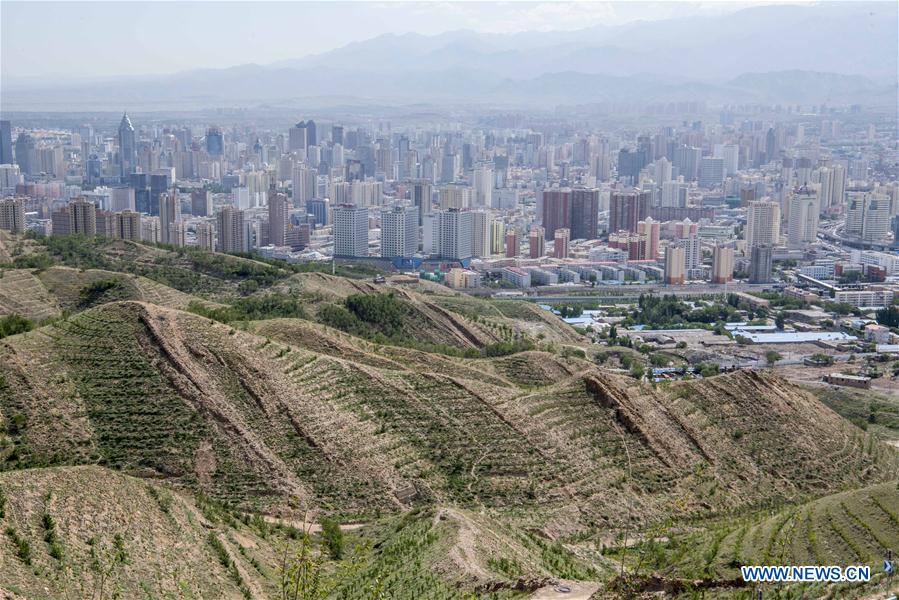In pics: afforestation greens Yamalik mountains in China's Xinjiang
Xinhua
1528716125000

This combination of pictures taken respectively in April 2009 (upper) and on June 7, 2018 shows ungreened and greened views of the Yamalik mountains in Urumqi, capital of northwest China's Xinjiang Uygur Autonomous Region. Decades of afforestation efforts by the government has turned the barren hill Yamalik mountains into a green paradise to curb sandstorms by planting trees. Once the biggest barren hill in Urumqi and a source of sandstorm that menace the city, the Yamalik mountains have been planted with more than 1.18 million trees over the past 20 years, with the current forest coverage of 2,200 hectares. (Xinhua/Hu Huhu)

A train runs at the foot of the Yamalik mountains in Urumqi, capital of northwest China's Xinjiang Uygur Autonomous Region, June 7, 2018. Decades of afforestation efforts by the government has turned the barren hill Yamalik mountains into a green paradise to curb sandstorms by planting trees. Once the biggest barren hill in Urumqi and a source of sandstorm that menace the city, Yamalik mountains have been planted with more than 1.18 million trees over the past 20 years, with the current forest coverage of 2,200 hectares. (Xinhua/Hu Huhu)

This combination of pictures taken respectively 0n April 16, 2011 (upper) and on June 7, 2018 shows ungreened and greened views of the Yamalik mountains in Urumqi, capital of northwest China's Xinjiang Uygur Autonomous Region. Decades of afforestation efforts by the government has turned the barren hill Yamalik mountains into a green paradise to curb sandstorms by planting trees. Once the biggest barren hill in Urumqi and a source of sandstorm that menace the city, Yamalik mountains have been planted with more than 1.18 million trees over the past 20 years, with the current forest coverage of 2,200 hectares. (Xinhua/Hu Huhu)

The Yamalik mountains are greened in Urumqi, capital of northwest China's Xinjiang Uygur Autonomous Region, June 7, 2018. Decades of afforestation efforts by the government has turned the barren hill Yamalik mountains into a green paradise to curb sandstorms by planting trees. Once the biggest barren hill in Urumqi and a source of sandstorm that menace the city, Yamalik mountains have been planted with more than 1.18 million trees over the past 20 years, with the current forest coverage of 2,200 hectares. (Xinhua/Hu Huhu)

Citizens do morning exercises on the Yamalik mountains in Urumqi, capital of northwest China's Xinjiang Uygur Autonomous Region, June 7, 2018. Decades of afforestation efforts by the government has turned the barren hill Yamalik mountains into a green paradise to curb sandstorms by planting trees. Once the biggest barren hill in Urumqi and a source of sandstorm that menace the city, Yamalik mountains have been planted with more than 1.18 million trees over the past 20 years, with the current forest coverage of 2,200 hectares. (Xinhua/Hu Huhu)

A staff member trims the green belt of the Yamalik mountains in Urumqi, capital of northwest China's Xinjiang Uygur Autonomous Region, June 7, 2018. Decades of afforestation efforts by the government has turned the barren hill Yamalik mountains into a green paradise to curb sandstorms by planting trees. Once the biggest barren hill in Urumqi and a source of sandstorm that menace the city, Yamalik mountains have been planted with more than 1.18 million trees over the past 20 years, with the current forest coverage of 2,200 hectares. (Xinhua/Hu Huhu)

The Yamalik mountains are greened in Urumqi, capital of northwest China's Xinjiang Uygur Autonomous Region, June 7, 2018. Decades of afforestation efforts by the government has turned the barren hill Yamalik mountains into a green paradise to curb sandstorms by planting trees. Once the biggest barren hill in Urumqi and a source of sandstorm that menace the city, Yamalik mountains have been planted with more than 1.18 million trees over the past 20 years, with the current forest coverage of 2,200 hectares. (Xinhua/Hu Huhu)


